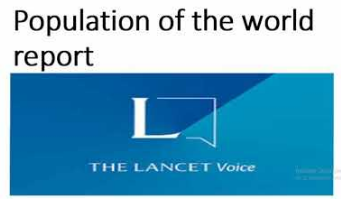(HOT) UPSC Current Affairs 2025 PDF
NEW! The Gist (OCT-2025) | E-BOOKS
(Article) LANCET REPORT- INDIA'S POPULATION FORECAST BY the YEAR 2048 TO 2100 & ITS CHALLENGES
(Article) LANCET REPORT- INDIA'S POPULATION FORECAST BY the YEAR 2048 TO 2100 & ITS CHALLENGES
Context :
The latest analysis report presented by Lancet shows that India's population is forecasted to be around 1.60 billion in 2048 from 1.38 billion as in 2017. In due course, it will show a 32% decrease & will be around 1.09 billion in 2100.
Basis:
- Researchers & experts used data from the 'Global Burden of Diseases studies 2017'.
- Global Burden of Disease study: It was initiated in 1990 with the collaboration of the World Health Organisation (WHO) & World Bank, where researchers & experts participate from all over the world. It is an overall global & regional level assessment considering mortality & disability due to major diseases, injuries & also risk factors.
- Total Fertility Rate (TFR): TFR is the average number of children who are expected to be born from a woman during her reproductive period from 15-49 years of age.
- Replacement Level Fertility: It is the number of children required to replace the parents after accounting for fatalities, infant mortality, skewed sex ratio, etc.
Forecasts related to India :
- Countries such as India & China will face a decline in the working-age population which will ultimately hamper economic growth.
- India will be the world's most populous country by the year 2100.
- India's working-age population aged 20-64 years is expected to decline to 578 million in 2100 from 762 million in 2017. In spite of this population reduction, India will still have the largest working-age population in the world.
- The study also showed that India will surpass China's workforce population by 2020s.
- China's current working-age population is 950 million in 2017 & expected to decline up to 357 million in 2100.
- Considering the year 2017 to 2100, India is expected to rise the global GDP ranking from 7th to 3rd in terms of nominal GDP.
- India's Total Fertility Rate (TFR) is less than 2.1 in 2019 & will keep on declining to 1.29 in 2100.
- India is also expected to have the world's second-largest immigration in 2100 with 0.5 million more immigration to the country than emigrating out in 2100.
- India is having the potential to offer a big manufacturing base for most of the immigrants who want to work here.

Global Forecast:
- The global population will be at its maximum level of 9.7 billion in 2064 & decline to 8.8 billion in 2100.
- The population of almost 23 countries like Japan, Thailand, Italy, Spain will shrink by more than 50%.
- 183 of 195 countries will have a TFR below the replacement level of 2.1 berths/woman.
- Global TFR will also decline from 2.37 in 2017 to 1.66 in 2100, which is again lower than the minimum required rate of 2.1
- Globally, the age structure will shift, where people having more than 65 years of age will be 2.37 billion by 2100 as compared to 703 million in 2019.
Challenges :
- Shrinking workforce, disease burden & social support for aging populations will be a big challenge for the economic & social growth of the country.
- Fertility reduction is bound to happen while giving priority to economic growth.
- Better life & improving health facilities will help in increasing the aging population.
- There is a big challenge to skillfully employ, skills-building to this huge working-age population of India, which otherwise may get wasted if not utilized properly or can turn into a demographic disaster.
Suggestions :
- To counter the shrinking working population, some liberal immigration policies can be adopted for the time as required.
- These migrants, new innovations in science & technology & new skills will subsequently boost the number of the working population.
- Technological advancements to be promoted can take over the working population shortage.
- To improve the women's fertility, the health system as well as greater economic freedom to be inculcated so that women can negotiate & live their life on their own terms.
Way Forward :
India is on the right track, since it is having enough workforce in this developing stage, only need is to use it efficiently. After having achieved a level of development policies can be aligned as per the population shift. Efficient human capital formation by skilling, training & education can be done to utilize them effectively.
MCQs
- What is Replacement level fertility?
- To replace the fertility of any human being.
- The number of children required to replace the parents.
- No. of children born from a woman during her lifetime.
- None of the above
Answer: Option b
2) Which organization/s is/are associated with the ‘Global burden of disease studies’?
- IMF, WHO, World Bank
- United Nations, SAARC, ASEAN
- WHO, World Bank only
- All of the above
Answer: c
MAINS
- Examine the pros & cons of India having the largest number of working-age populations. Explain it in context with neighboring countries like China.
- How skilling of the workforce should be done to utilize the working-age population. Is it a boon or curse to have a huge working population & how it affects the economic growth of the country?
Happy Studies!
Printed Study Material for UPSC IAS Exams
Online Coaching for IAS PRELIMS Exam
© IAS EXAM PORTAL


